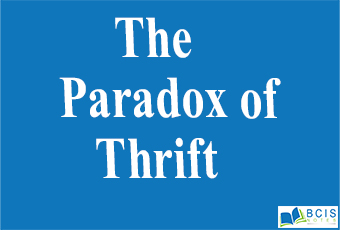
Paradox of Thrift
The paradox of thrift refers to contrasting implications of savings to households and to the economy as a whole.
Saving is treated as a virtue by households as they provide a protective umbrella against bad spells but the same is treated as a vice by the economy as it delays the process of income generation.
Since the start of human civilization, it was considered a virtue to keep consumption level at the minimum but the lasting effects and chain reactions of keeping consumption in check were not realized. People were taught that thrift or savings are good because a penny saved today will bring increased income.
In this connection, Keynes pointed out the ‘paradox of thrift’ and showed that as people become thriftier, they end up saving less or the same as before. If all the people of an economy increase the proportion of income which is saved (i.e., MPS), the value of savings in the economy will not increase, rather it will decline or remain unchanged. Let us understand this statement with the help of the figure.

In the figure, the initial saving curve is SS and the investment curve is II. The economy attains equilibrium (Saving = Investment) at E and the equilibrium level of income is OY. Now, suppose the society decides to become thrifty by reducing consumption expenditure and Increases saving by, say, AE. As a result, the saving curve shifts upward to S1S1 intersecting Investment curve II at E1.
Unplanned inventories will increase and firms will cut down production and employment and move to new equilibrium E1. The figure shows that in the end, saving has fallen from AY to E1Y1.
Notice at the new point of equilibrium E1, investment level and also realized saving remain the same (E1Y1) but the level of income has fallen from OY to OY1.
The decline in the equilibrium level of income shows the paradox of thrift as the reverse process of multiplier has worked on reducing consumption expenditure. In fact, Increased saving is virtually a withdrawal from the circular flow of income.
You may also like: Saving Function

Leave a Reply